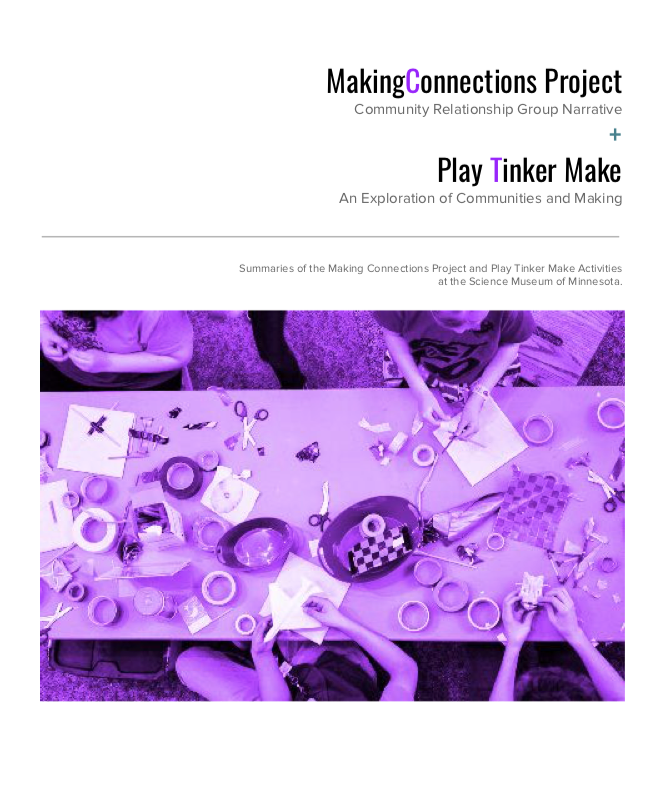Shifting Museum Practices with a New Vision of Making
This blog was co-written by Marjorie Bequette, Director of Evaluation and Research in Learning at the Science Museum of Minnesota, and Gina Navoa Svarovsky, Assistant Professor of Practice at the University of Notre Dame’s Center for STEM Education.
Making Connections began in 2013 with a vision of a more diverse and inclusive Science Museum of Minnesota (SMM), where families of color would choose to engage with the museum in similar ways, at similar rates and depths as white families. At that time, SMM (like many other museums) saw fewer visits from people of color than would be predicted by local demographics. This ambitious goal, which we expected to move toward but not achieve during the project, would be supported by research with local families of color on how they perceived making and hands-on activities, and how they saw museums as playing a part in their family lives.
The centerpiece of the project was Saturday public programming at the museum—a series of open-ended, facilitated, tabletop activities called Making Connections Saturdays which provided opportunities to participating families to lead facilitation and supported more independence in museum visits. Key to developing these were Community Listening Sessions which built initial trust and understanding of families’ at-home making practices and Co-Design Workshops in which we began developing new ideas for the Saturday program and continued to establish mutual understandings of making. We also hosted a final celebration for families to mark the end of the project and share some of our findings with them.
From the start, the project was planned with the participation of multiple internal and external partners. Within the museum, we included educational researchers, our community engagement team, members of the marketing department, and our programming team (who were responsible for creating and delivering Making-based events on the museum floor). We also had multiple community partners, over 10 by the end of the project, as well as relationships with local leaders who identified as African-American, Hmong, Dakota, Ojibwe, and Hispanic/Latinx and were well-connected in those communities.
Making Connections: Exploring Culturally Relevant Maker Experiences through an Iterative, Cross-Institutional Approach was funded by the National Science Foundation’s Advancing Informal STEM Learning program, award no. 1323584. Video from SMM Exhibits on Vimeo.
Developing a New Kind of “Research Product”
From the beginning of the project, researchers and practitioners worked collaboratively together. As we did so, we got comfortable sharing what was hard for us in our own work, and asking each other for help. In many cases, we also helped each other look for resources beyond SMM that might help inform us. As we got close to the end of the project, we wanted to write the type of document we wish had existed when we started our journey—evidence that would help us to see that what was hard for us might have also been a struggle for others, i.e., a guide that might have helped us to avoid some of the particular challenges we faced.
The Making Connections Practitioner Guide
 Written primarily by practitioners, the Making Connections Practitioner Guide shares some real challenges: microaggressions, friction points, and where we messed up. We describe how we developed skills as a team, and the internal vocabulary that helped us to articulate what was going on, to process, and to address these issues. We also included descriptions of the project staff and how we worked together, how we got started and built trust with each other, and how we worked with our external partners in powerful ways.
Written primarily by practitioners, the Making Connections Practitioner Guide shares some real challenges: microaggressions, friction points, and where we messed up. We describe how we developed skills as a team, and the internal vocabulary that helped us to articulate what was going on, to process, and to address these issues. We also included descriptions of the project staff and how we worked together, how we got started and built trust with each other, and how we worked with our external partners in powerful ways.
As we describe the various events that we held, like family listening sessions and open houses, we not only include a description of what we did and why, but also insights into what we would recommend if you try this. We want this to be useful and usable for others and thought about that at every step of the way. We also describe our process for co-developing activities with community members and a full list of the activities we developed.
On the Making Connections Padlet page, you can find a selection of activity guides, our internal staff reading list on museums and race, and other project documents.
Co-writing with Practitioners and Researchers
Writing this guide needed to be done by the project team, even though many of these folks aren’t frequently writing reports for a broader audience. We worked together to talk about what they wanted to say, and to figure out what kinds of supports were important for them. Internal and external editors, flexible deadlines, gentle and persistent reminders, and discussions about the importance of sharing our learning—all were key to the process. Many of these staff members had also been part of conference presentation groups before writing the final product, so the challenge wasn’t as much about what to say as it was that written reports are harder for some to produce. And we will be frank: this was a difficult document to produce, but we are glad we did it and will do it again for future projects.
Our team would love the hear your reactions to the practitioner guide. Email us at mbequette@smm.org.
